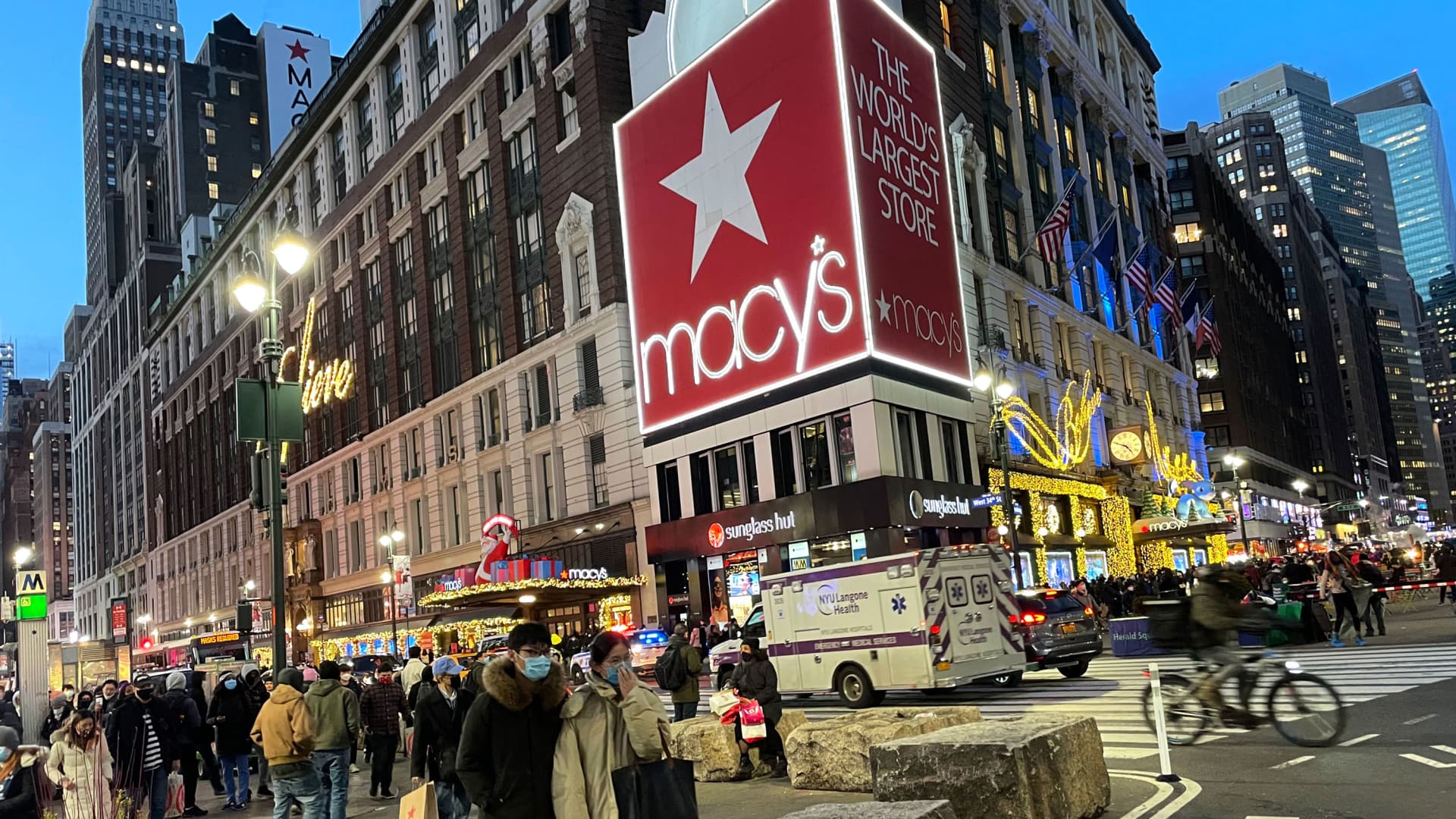Macy's raises earnings forecast, says it has fresh inventory for the holidays
Macy's raised its earnings forecast for the year after the department store operator said its inventory is well positioned for the holiday shopping season.

Macy's flagship store in Herald Square in New York, Dec. 23, 2021.
Scott Mlyn | CNBC
Macy's on Thursday raised its earnings forecast for the year as strong luxury sales boosted the department store operator's quarter and fresh merchandise arrived for the holidays.
The company left its revenue guidance unchanged though, after trimming projections in August, as it faces a tougher sales backdrop during the retail industry's most crucial quarter. The updated outlook came after Macy's reported third-quarter revenue and earnings that topped Wall Street expectations.
Shares of Macy's were up nearly 8% in pre-market trading.
In an interview with CNBC, Macy's CEO Jeff Gennette said company can hold the line on prices because it has fresh merchandise. That has allowed it to bring in new apparel, home goods and other gift-giving items. He said it is not seeing customers trade down to cheaper brands.
However, he said Macy's did see a drop in sales in the final weeks of October and early November. Store and website visits remained the same — but the browsing did not lead to buying. In the past week, he said, Macy's has seen a return to a better performance.
"Is that a slowdown in the consumer confidence that we are going to take all the way through the fourth quarter?" he said. "Or is it going back to the 2019 buying patterns when those weeks I'm quoting were actually consistent with the trend we had before ramping into Christmas this year? Right now, we are watching it very carefully."
Here's how Macy's did in its fiscal third quarter ended Oct. 29 compared with what analysts were anticipating, based on Refinitiv estimates:
Earnings per share: 52 cents adjusted vs. 19 cents expectedRevenue: $5.23 billion vs. $5.2 billion expectedFor the three month period ended Oct. 29, Macy's said Thursday that its net income fell to $108 million, or 39 cents per share unadjusted, down from $239 million, or 76 cents per share, a year earlier.
Macy's is trying to refresh its business, on top of navigating a fast-changing economic backdrop. It is in the middle of turnaround plan, dubbed Polaris, which has included store closures, investments in e-commerce and efforts to draw younger customers to its stores.
Compared with other retail players, Macy's has missed out on huge gains in sales during the pandemic — even as shoppers spent stimulus checks. Its revenue has remained relatively flat, coming in at $5.17 billion during the third quarter of 2019, at $3.99 billion in the third quarter of 2020 and at $5.4 billion in the third quarter of 2021. That compares with $5.23 billion in the third quarter of this year.
Comparable sales on an owned plus licensed basis fell 2.7% during the period from a year ago. That was better than 4.3% decline that Wall Street expected, according to Refinitiv.
Still, Macy's is in a better spot than many of its competitors in terms of inventory. Its inventory level was up 7% year over year in the second quarter and up 4% year over year in the third quarter. Compared to 2019 levels, its inventory in the third quarter was down 12% — a reflection of sharper management of goods, but out-of-stocks and shortages in the earlier part of the pandemic.
Spending shifts
The retailer has seen a shift in what people are buying in the past few quarters, as shoppers bought dressier attire instead of the pajamas, workout clothes and home goods like bedding that they loaded up on earlier in the pandemic, Gennette said. That pattern held in recent months, he said.
Luxury, in particular, was a point of strength during the quarter. Shoppers turned to Macy's beauty chain, Bluemercury, and higher-end department store chain, Bloomingdale's, to buy new clothing, shoes and makeup. Those banners outperformed the rest of the company.
At Bloomingdale's, comparable sales on an owned plus licensed basis were up 4.1%, as shoppers bought dressy clothing, women's shoes and luggage.
At Bluemercury, comparable sales on an owned plus licensed basis rose 14%.
Gennette said the company benefits from having store banners with a wide array of price points — so shoppers can choose a high-end fragrance and then a lower-priced shirt from a private label.
Heading into the key holiday shopping season, Macy's is facing inflation that's hovering at a near four-decade high. The company cut its full-year revenue and earnings per share forecast in August, saying it anticipates shoppers may spend less on discretionary merchandise like apparel as they pay more for groceries, housing and gas.
Earlier this week, industry-watchers got fresh clues about the health of the consumer. Both Walmart and Target reported a noticeable pullback of sales in categories like apparel, electronics and home goods as shoppers spent more on necessities. Target slashed its forecast for the holiday quarter, saying weaker sales have continued into November.
Macy's, by contrast, stood by the revenue guidance it gave in August, saying it still expects a range of $24.34 billion to $24.58 billion for the fiscal year. It raised its annual adjusted earnings per share forecast to $4.07 to $4.27 per share, up from its previous range of $4 to $4.20.
As of Wednesday's close, Macy's shares are down about 25% so far this year. Shares closed Wednesday at $19.71, down about 8%.

 UsenB
UsenB 






























